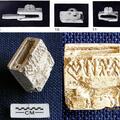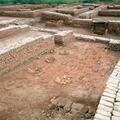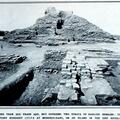Whether or not the recent new pushing back ancient Chinese civilization thousands of years is true or not, it is likely that the origins of all ancient civilizations will be pushed back in the years to come. We know very little about possible antecedent cultures, whether in Rakigarhi, Balochistan, southwestern Iran or northern China.
344 posts, also carried on our Facebook page, about the ancient Indus Valley civilization, including important news, research and occasional visits to museums with ancient Indus artifacts.
Jan 9, 2015
Decorated terra cotta cones are found at both Mohenjo-daro and Harappa, but no one knows what they may have been used for. Some scholars suggest that they were hung on a string as a plumb-bob for use by masons and carpenters.
Jan 5, 2015
It might be nice to step into the new year with the figure of a dancer, for dancing is something - there is every indication from the dancing girl to this - that the ancient Indus people took very seriously.
Jan 2, 2015
Not yet absolutely clear that this is an ancient Indus-style crown, but the chances are pretty good with find first reported in August. Reports on follow-up excavations in December by A.K.
Dec 17, 2014
Humped bull figurine from Mohenjo-daro with molded head that is twisted to the side, and a mold used to make the head. The legs were made separated rather than being joined together. Hand formed body and attached head.
Dec 15, 2014
Only a few specimens of this unicorn amulet-type seal have been found.
Dec 10, 2014
"This room in VS area was made with bricks set on edge to create a watertight floor. A small well was located in the southeast corner (top right) and circular brick depressions were set into the floor, presumably to hold pottery vessels.
Dec 10, 2014
John Marshall writes of House 8, an "average upper class house" in the HR section of Mohenjo-daro: "To the right of the porter's lodge [5] a short passage led to the central courtyard of the house (18), which was open to the sky and provided light and air to
Dec 8, 2014
The first images of the announcement of the discovery of the ancient Indus Valley civilization in the Illustrated London News, on September 20, 1924. "The remarkable discoveries here illustrated put back by several centuries the date of the earliest known
Nov 27, 2014
This set of steatite disc beads found at Harappa, each about 1 cm in diameter, were found in a Kot Diji phase (ca. 2800-2600 BCE) street and appear to be a necklace segment that was lost in the trash. The manufacturing marks are clearly visible.
Nov 25, 2014
Ringstones are among the most fascinating of ancient Indus objects, particularly after recent research has shown some of those at Harappa to have originally been manufactured near Dholavira and then transported some 1,000 kilometers north.
Nov 18, 2014
The impressions of a pipal leaf found in the upper clay levels of a drain in Harappa, shown here with a modern pipal leaf, indicate that what many think was a sacred tree was growing in the ancient city of Harappa even at that time.
Nov 10, 2014
Indus Tigers found at Harappa in recent years, often anthropomorphized. "The most dangerous animals living in the vicinity of the Indus cities were tigers and leopards.
Oct 12, 2014
Image niche and stairway to left ascending to platform of stupa at Mohenjo-daro, modern shot and Bison Seal (ca. 2500 BCE). "This image niche is 7 feet deep by 4 ft.
Oct 10, 2014
Indus pointed base goblets from Mohenjo-daro. Found only in the largest cities and towns, these cups appear to have been used once and then tossed away, as is the case with disposable terra cotta cups in the cities of Pakistan and India today.















